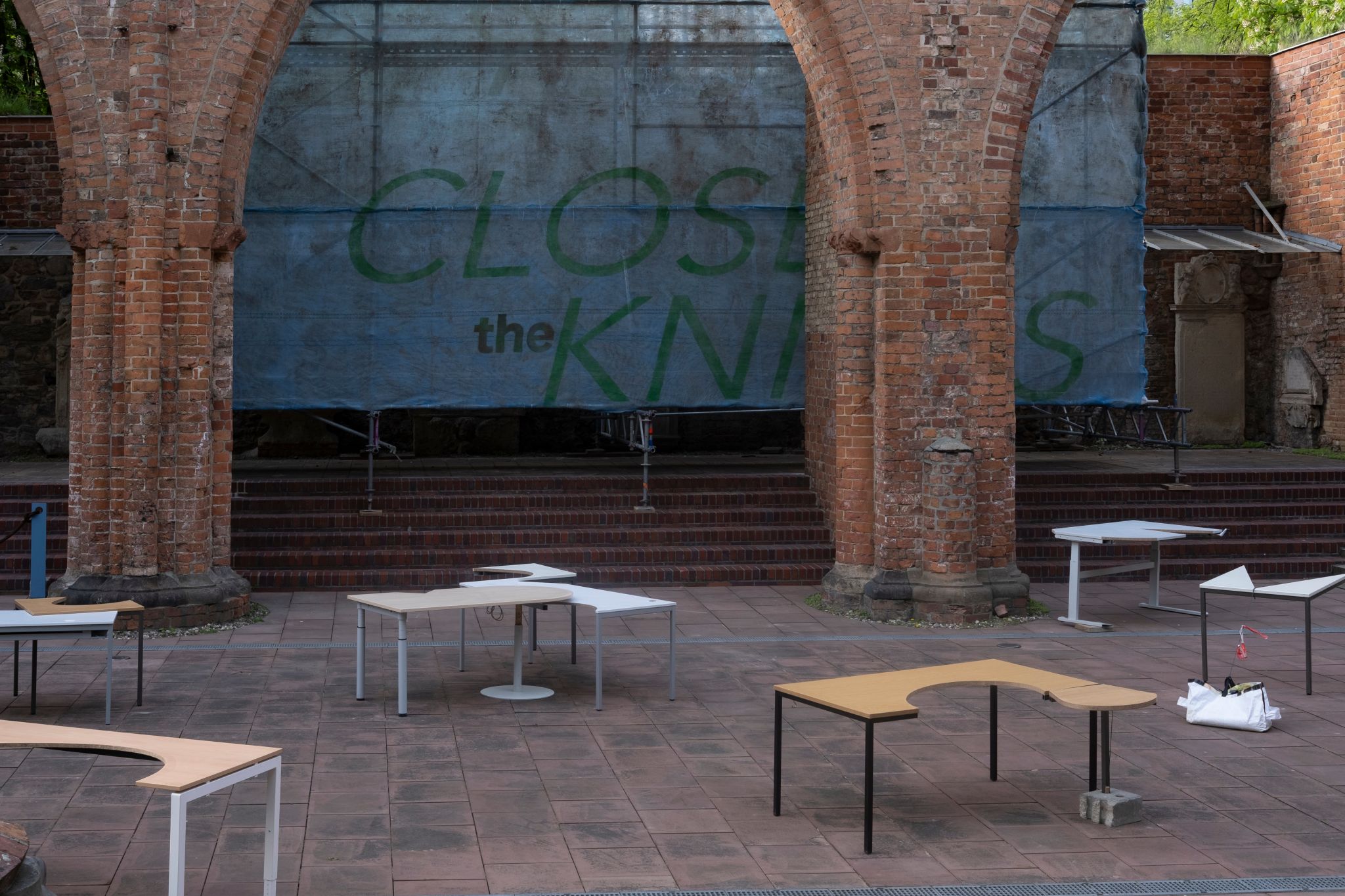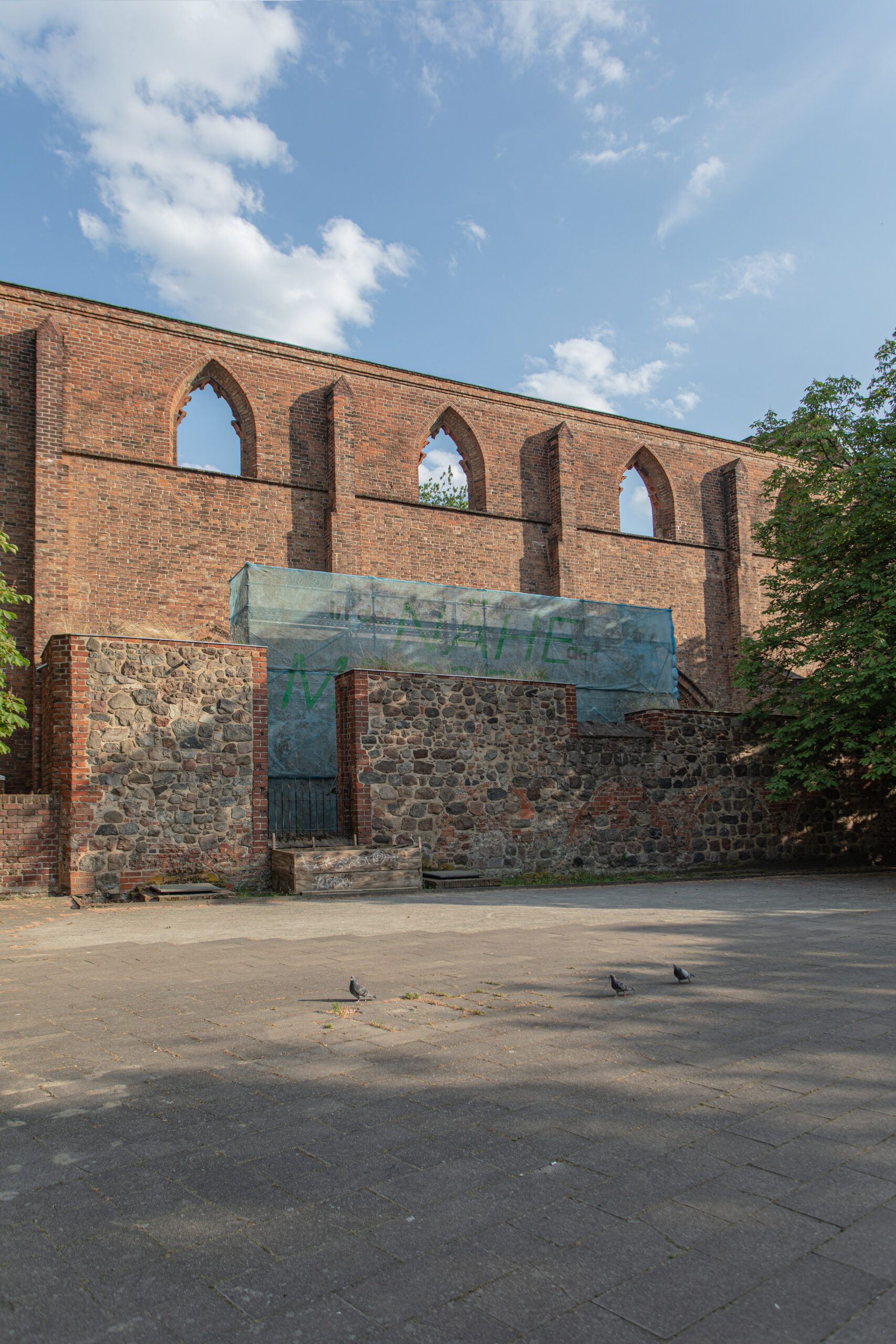-
Gerry Bibby’s Lobby presents a series of interventions and sculptural works at Klosterruine Berlin that open up new visual and spatial relationships to the exhibition site as well as to the urban texture and its underlying power structures. To this end, Bibby uses materials and objects that circulate within public infrastructure - architectural elements from public spaces, furniture and functional objects from areas of administration.
read moreEntry to Bibby’s Lobby is through the south aisle. Normally made via the portal, it is restructured by the artist to the declared barrier-free main entrance. Through this invisible intervention, he alters the flow and orientation to the building, subtly calling attention to the structural obstacles that non-normative bodies face in the urban environment. The pivot point of the building’s architectural axis thus created directs the focus of the body’s movement to the space of the center - an open, non-linear, but dispersed place - rather than to the otherwise privileged space of the former nave, which presumes only unidirectional movement. Bibby’s spatial reorientation, however, also appropriates the humorous moment that may resemble exclusive access via a backstage.
Lobby can be understood here in multiple senses. As an entrance hall, waiting area or foyer, a lobby structures access and serves to organise circulation and distribution in (semi-)public buildings such as hotels, banks, offices, or corporations. As an interest group, a lobby is an association of people for a common goal. As the latter, it operates at a para-political level, not directly involved in political decision-making, yet exerting significant influence on it (1). Bibby uses the idea of the lobby here to construct a new space within the Klosterruine.
It’s function for indeterminate gathering led the architect and philosopher Siegfried Kracauer at the beginning of the 20th century to understand the hotel lobby as an inverted church: “The typical characteristics of the hotel lobby [...] indicate that it is conceived as the inverted image of the house of God. It is a negative church [...]. In both places people appear there as guests. But whereas the house of God is dedicated to the service of the one whom people have gone there to encounter, the hotel lobby accommodates all who go there to meet no one.”(2) The lobby functions - in contrast to the sacred gathering place of the community, or the purpose-built office space of administration and business - as a place of transit and dispersion, where society breaks down into its component parts - but which may at the same time serve as a space to form counterpublics.
The work Dust Jacket occupies an intermediate space in the opposite aisle of the monastery ruins – now experienced frontally albeit behind the gothic arches in an area designated off-limits to visitors. Visible and hidden at the same time, it can only be seen in sections from both inside and outside. Painted with lettering, it simultaneously refers to itself as well as to the space behind it: seeming like an announcement, as much a promise for the future as a record of a past moment. The work is based on conventional building materials - scaffolding, which dominates its immediate surroundings, and dust nets, which drape a scaffolding’s exoskeleton to protect against falling material during construction. Bibby merges the nets in multiple layers, enclosing sand and dirt from the urban environment within the mesh. Like a container, Dust Jacket takes in sediment from the city. The lettering brings forth associations with advertising posters, which define visual communication in public space and usually have a commercial purpose, but here “Close to the Knives” refers to the memoir of the same name by artist David Wojnarowicz (1954-1992), whose diverse practice was at once highly personal, and radically political. In his varied work, including video, photography, painting, and assemblage, as well as murals in public space, he drew attention to prevailing grievances, especially in the context of the AIDS epidemic. His autobiography, published in 1991, is subtitled “A Memoir of Disintegration” and portrays his life as one outside the social norm, in which art and the relationships that accompany it create a space of solidarity. Bibby, then, refers to an artist who is both influential to his own practice, in whose work life and art are inextricably linked, and in which beauty, sadness, dirt, joy, rage, the libidinal, the ugly, and love are continuously intertwined.
In the centre room of the Klosterruine, Bibby presents Invitation 1 – 11, a series of sculptures made from discarded conference tables and desks. In part, they come from surrounding institutions - the courthouse, civic office, or cultural institution - typical sites of administration, negotiation, management and culture production. Bibby adopts cut-ups and montages that undermine the function of the tables and suggest new forms of social interaction and decision making processes. Bibby asked surrounding institutions for donations of tables for his work. In his request, he described his personal relationship to art and to the city of Berlin – a subjective, intimate narrative that contrasts with the ordering logic of administration.
The tables make up a central part of the inventory of bureaucracy and office work and yet are often overlooked as “service architecture”(3). Rarely do they play a main role, primarily serving to provide a framework for another event. Tables establish relations of proximity and distance - between those sitting at the table and to their environment. As a place of negotiation, the table also has a special significance within political processes: “The table [...] became an explicitly political object that mediated between a potentially confusing ‘ground’ by establishing a second ‘ground’ above the floor around which an ideal order could make itself manifest. It became a medium of social articulation, as well as a metric of social reproduction”(4). Through the treatment of the tables, through voids, gaps, and breaks in their surfaces, Invitation 1 – 11 refer to the conflicts and disparities that are constitutive of social spaces: “conflict, far from [being] the ruin of democratic public space, is the condition of its existence”(5).
Bibby's artistic work oscillates between critique and collaboration. He exposes the relationships created by spatial arrangements and architecture, while at the same time introducing functional objects into the exhibition space that append its infrastructure. Fountain consists of a water dispenser that informs the interior of office, administrative, or waiting spaces. Over the duration of the exhibition, the water dispenser is continually refilled and can be used by visitors and staff. The Klosterruine does not have its own water access and the immediate surroundings do not offer any free municipal water dispensers. Bibby not only points to an empty space in an environment characterised by consumption, but also extends the infrastructure of the exhibition site for a limited time. As a readymade, rented from the city's circulation of goods and fed back into it after the exhibition period, it is also a winking allusion to Duchamp.
By employing humour alongside other communicative registers, Bibby's Lobby demonstrates the relationships of dependency that shape public space. Through his intervention in the space of the Klosterruine, he choreographs modes of relationship between people, objects, and spaces, pointing to the potential for protest and poetry that can emerge in the gaps and interstices of the public sphere.
1) The name derives from the term for the anteroom of the British Houses of Parliament, the place where members of parliament and people who were not elected representatives and therefore were not allowed into the meeting room conversed.
2) Siegfried Kracauer (1977): Hotelhalle. In (Ibid.): Ornament und Masse, Frankfurt: Suhrkamp. S. 157.
3) Jasmin Meerhoff, Markus Krajewski, Stephan Trüby (2017): Dienstbarkeitsarchitekturen. Zwischen Service-Korridor und Ambient Intelligence. Berlin: Wasmuth Verlag.
4) Sasha Rossmann (2020): On Neutral Grounds Gerard Ter Borch’s. The Swearing of the Oath of Ratification of the Treaty of Münster, 15 May 1648. In: Le Fond de l'œuvre. Arts visuels et sécularisation à l'époque moderne, eds. Emilie Chedeville, Etienne Jollet, Claire Sourdin, Paris, Editions de la Sorbonne, coll. “Histo.art” 12, p. 154.
5) Rosalyn Deutsche (1996): Evictions. Art and Spatial Politics. Cambridge, Mass-London: MIT Press, p. xxiv.
This raises a multitude of questions about inclusion and exclusion within political decision-making: Who is invited to participate in the participatory process? Who is allowed to speak and who listens? Is there even a common language? The power of the better argument, as Jürgen Habermas formulated in his erstwhile conception of the public sphere, usually corresponds to the power of those who bring socially recognized, i.e. hegemonic, qualities to the table. Designs of queer-feminist, proletarian, or postcolonial counterpublics shaped the understanding of exclusions from the normative structures of the historically developed public sphere. Feminist theorist Lauren Berlant, following Michael Warner, speaks of intimate publics that take place in the sphere secondary to the political and encompass informal networks, friendships, or alliances. They open up a field of recognition and are a world-building project without inserting themselves into dominant institutions.
Text: Juliane Bischoff
Photos: Silke Briel, Joanna Krawczyk
Performance, 27.05.2023
Performative readings by invited guests activated the presented installations and brought them into new constellations.
The artist states:
„Much of Lobby has been wrapped up in an amplified call & response dynamic. Beginning, like most exhibitions, with the curator‘s initial invitation, a whole series of requests, expectations fulfilled or otherwise, obstructions, deals & decisions followed.
Invitations 1–11 as sculpture began with me digesting numerous images of table-shapes coupled with reportage of large-scale decision making. These followed with call-outs in the form of letters I addressed to all the city & state buildings, cultural institutions, and even the local fire station, in direct proximity to the ruin.
I wrote:
“I write here however with a wish to also include your involvement in the process of the exhibition’s making by contributing commonplace objects from your working surrounds.”
“To be expected the same area now looks very different and the numerous people who visit today will encounter an entirely other view through a train’s window.”
&
“Despite during this time and still not being able to engage electorally in Germany […] I would suggest my experience as an immigrant has allowed me a complex vantage point from which to think of place and my relation to it.”
Some replied, others didn’t. But now that all this combines in object form on site — I also wrote “[…] I am particularly interested in tables that promote the coming together of many bodies” – the Invitations are ripe for response.
A number of guests will join a gathering for readings of some borrowed & new texts, and discussion on Saturday the 27th May at 5pm. Please join regardless of having replied or not.
Until then,
Gerry Bibby“
Wednesday – Friday 12 – 6 pm
Saturday 12 – 4 pm and by appointment
-
Gerry Bibby’s Lobby presents a series of interventions and sculptural works at Klosterruine Berlin that open up new visual and spatial relationships to the exhibition site as well as to the urban texture and its underlying power structures. To this end, Bibby uses materials and objects that circulate within public infrastructure - architectural elements from public spaces, furniture and functional objects from areas of administration.
read more
Gerry Bibby
Dust Jacket, 2023
Scaffolding, Dust net, sand, paint
8 × 12 × 1,5 m
Gerry Bibby
Invitation 1 – 11, 2023
Reclaimed office furniture, paint, weights
Dimensions variable
Gerry Bibby
Fountain, 2023
Water Cooler, water bottles
1 × 0,3 × 0,3 m



